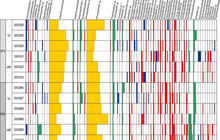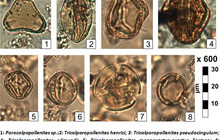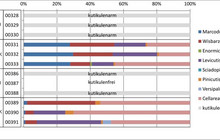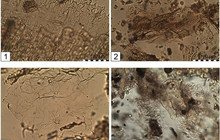Geology: Seam anomaly in the open-pit mine Welzow-Süd
The seam anomaly inthe open-pit mine Welzow-Süd is an elongated structure, which differs from the normal-facies seam build-up. Further occur doubling of seam parts due to thrust faults, distribution gaps of the interburden 2, the local occurrence of the horizon 11 as well as a settlement-caused seam arching and the absence of upper lignite horizons due to hanging wall silt transgression.
For detailed characterization of this anomaly, the transition area hanging wall silt / lignite was detailed sampled and macro petrographical defined by several sections in cm steps. The total of 5 sections are located in as well as outside the fault area.
To get knowledge about the timing of formation of the transition area in the hanging wall of the 2. Lusatian seam, one section each in and outside of the anomaly were examined by palynology and cuticular analysis.
The palynological investigation of the lignite and silt samples took place by a transmitted light microscope at a magnification of 400x up to 600x. The examination resulted in a similar population of palynomorphs in the samples of the faulted and non-faulted area. Further, the silt samples show a similar population of palynomorphs like the underlying lignite samples. Both of the silt samples, which are located at the contact to the lignite, contain hystichosphaeridae. This oceanic plankton indicates a saltwater entry during the deposition of the silt.
Over 50 forms and form groups of pollen and spores were acquired.
At cuticular analysis the inspection of the preparation takes place at a magnification of 200x by transmitted light microscopy. The indicated for the lignite samples of both sections a P / G-facies, which is characterized by pinus cork cells, pinicutis and versipalmicutis (P-facies) as well as levicutis (G-facies). The silt samples are poor or free of cuticles.
Conclusion:
The palynological examination could prove, that the silt formation inside and outside of the fault area is the same. Probably, no large time gap exists between the end of lignite formation and the deposition of the silt. Otherwise, the silt would contain other palynomorphs than the underlying lignite.
project overview
- Disposals by the wayside
- Deposits in systems of industrial facilities
- Analytics of fibers
- Microscopic analysis of construction material
- IHS-Cinder-Conditioning
- Seam anomaly in the open-pit mine Welzow-Süd
- Sediment petrographic investigation of the Meuro Formation
- Scanning Electron Microscopy of dust precipitations
- The "Venus" vom Hohle Fels
- Investigation of corrosion in plant engineering and construction
- Study of clinker formation in power plant processes
- Survey of geological structures using GPS
- Maceral analysis and microscopic evaluation of peat samples
- Evaluation of a coal seam sequence in the surface mine V. Schleenhain
- Coal quality treatments
- Faciel correlation of archeological findings
- Mapping of sulfur content
- QMAT
- Study of selected section areas of the exploratory drilling in the forefield of the surface mine Jänschwalde
- Xylite classification
- Cuticular analysis
Special methods
SEM
Surface analysis and microchemical examination



